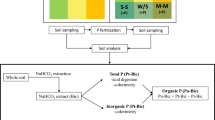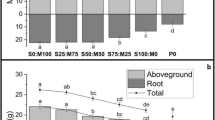Abstract
Legume-cereal rotations are an essential component of integrated soil fertility management in low-input cropping systems, but strategies are needed to increase phosphorus (P) fertilizer use efficiency in such systems. These may include preferential targeting of P to one of the crops in the rotation cycle, the use of P-efficient genotypes, and the optimization of the rates of P fertilizer used. A field trial was conducted to evaluate the effects of increasing P fertilizer rates (0, 11, 22 and 44 kg P ha−1, added as triple super phosphate) applied to three soybean genotypes grown on a P-deficient Ferralsol, on the nitrogen (N) and P nutrition of a subsequent maize crop. In addition, a greenhouse trial was set up to assess N, P and other rotation effects of three soybean genotypes on a subsequent maize crop relative to a maize–maize rotation at high and low P supply. In the field trial, soybean did not respond to increasing P rates, but residual P effects improved maize grain yields by up to 90 %. Ear leaf (field trial) and shoot (pot trial) P concentrations increased by applying N to maize, demonstrating important N × P interactions. The pot trial did not reveal a positive rotation effect of soybean on maize beyond the mere N-benefit, showing that soybean was not able to improve P availability to maize after correcting for the N-effect. No variation in rotation effects on maize among soybean genotypes was observed. Because of the absence of effects of the soybean crop on P availability to maize, opportunities to increase P fertilizer use efficiency in soybean–maize rotations mainly reside in maximizing P uptake by each crop separately and in matching P fertilizer rates with crop demand.






Similar content being viewed by others
References
Abaidoo R, Sanginga N, Okogun JA, et al (2007) Genotypic variation of soybean for phosphorus use efficiency and their contribution of N and P to subsequent maize crops in three ecological zones of West Africa. Demand-driven Technol. Sustain. maize Prod. West Cent. Africa. Proc. fifth Bienn. Reg. maize Work. IITA-Cotonou Benin Republic, 3–6 May, 2005. WECAMAN/IITA, Nigeria, pp 194–224
Alvey S, Bagayoko M, Neumann G, Buerkert A (2001) Cereal/legume rotations affect chemical properties and biological activities in two West African soils. Plant Soil 231:45–54
Bennett WF (1993) Nutrient deficiencies and toxicities in crop plants. APS press, St. Paul
Carsky RJ, Oyewole B, Tian G (2001) Effect of phosphorus application in legume cover crop rotation on subsequent maize in the savanna zone of West Africa. Nutr Cycl Agroecosyst 59:151–159
Cassman KG, Munns DN, Beck DP (1981) Growth of Rhizobium strains at low concentrations of phosphate. Soil Sci Soc Am J 45:520–523
Chhabra R, Pleysier J, Cremers A (1975) The measurement of cation exchange capacity and exchangeable cations in soil: a new method. In: Proceedings of the International Clay Conference. Applied publishing Ltd., Wilmette, IL, pp 433–499
Day P (1965) Particle fractioning and particle size analysis. In: Black C et al (eds) Methods of soil analysis, part 1. ASA, Madison, pp 545–562
FAO-ISRIC (2006) World reference base for soil resources. Food and Agriculture Organization of the United Nations
Fyson A, Oaks A (1990) Growth promotion of maize by legume soils. Plant Soil 122:259–266
Giller KE, Cadisch G (1995) Future benefits from biological nitrogen fixation: an ecological approach to agriculture. Plant Soil 174:255–277
Hinsinger P (2001) Bioavailability of soil inorganic P in the rhizosphere as affected by root-induced chemical changes: a review. Plant Soil 237:173–195
Högberg P (1997) 15 N natural abundance in soil-plant systems. New Phytol 137:179–203
Houngnandan P, Yemadje RGH, Oikeh SO, Djidohokpin CF, Boeckx P, Van Cleemput O (2008) Improved estimation of biological nitrogen fixation of soybean cultivars (Glycine max L. Merril) using 15 N natural abundance technique. Biol Fert Soils 45:175–183
Institute Inc SAS (2012) SAS/STAT 9.3 user’s guide, 2nd edn. SAS Institute Inc, Cary
Jemo M, Abaidoo RC, Nolte C et al (2006) Phosphorus benefits from grain-legume crops to subsequent maize grown on acid soils of southern Cameroon. Plant Soil 284:385–397
Jemo M, Nolte C, Tchienkoua M, Abaidoo RC (2010) Biological nitrogen fixation potential by soybeans in two low-P soils of southern Cameroon. Nutr Cycl Agroecosyst 88:49–58
Kamh M, Abdou M, Chude V et al (2002) Mobilization of phosphorus contributes to positive rotational effects of leguminous cover crops on maize grown on soils from northern Nigeria. J Plant Nutr Soil Sci 572:566–572
Kihara J, Kimetu J, Vanlauwe B et al (2007) Optimising crop productivity in legume-cereal rotations through nitrogen and phosphorus management in western Kenya. In: Bationo A, Waswa B, Kihara J, Kimetu J (eds) Advances in Integrated soil fertility management in Sub-Saharan Africa: challenges and opportunities, vol XIV. Springer, New York, pp 493–502
Kihara J, Vanlauwe B, Waswa B et al (2010) Strategic phosphorus application in legume-cereal rotations increases land productivity and profitability in Western Kenya. Exp Agric 46:35–52
Latif MA, Mehuys GR, Mackenzie AF et al (1992) Effects of legumes on soil physical quality in a maize crop. Plant Soil 140:15–23
Liao H, Wan H, Shaff J et al (2006) Phosphorus and aluminum interactions in soybean in relation to aluminum tolerance. Exudation of specific organic acids from different regions of the intact root system. Plant Physiol 141:674–684
Lockman RB (1969) Relationships between corn yields and nutrient concentration in seedling whole-plant samples. Agron. Abstr. American Society of Agronomy, Madison
Ogoke IJ, Carsky R, Togun A, Dashiell K (2003) Effect of P fertilizer application on N balance of soybean crop in the guinea savanna of Nigeria. Agric Ecosyst Environ 100:153–159
Okalebo JR, Gathua KW, Woomer PL (1993) Laboratory methods of soil and plant analysis: a working manual. Tropical Soil Biol Fertility Programme
Ozanne PG, Shaw TC (1968) Advantages of the recently developed phosphate sorption test over older extractant methods for soil phosphate. Trans 9th Int Congr Soil Sci 2:273–280
Parkinson JA, Allen SE (1975) A wet oxidation procedure suitable for the determination of nitrogen and mineral nutrients in biological materials. Commun Soil Sci Plant Anal 6:1–11
Pypers P, Huybrighs M, Diels J et al (2007) Does the enhanced P acquisition by maize following legumes in a rotation result from improved soil P availability? Soil Biol Biochem 39:2555–2566
Richardson AE, Lynch JP, Ryan PR, Delhaize E, Smith FA, Smith SE, Harvey PR, Ryan MH, Veneklaas EJ, Lambers H, Oberson A, Culvenor RA, Simpson RJ (2011) Plant and microbial strategies to improve the phosphorus efficiency of agriculture. Plant Soil 349:121–156
Sanginga N (2003) Role of biological nitrogen fixation in legume based cropping systems; a case study of West Africa farming systems. Plant Soil 252:25–39
Sanginga N, Dashiell K, Okogun JA, Thottappilly G (1997) Nitrogen fixation and N contribution by promiscuous nodulating soybeans in the southern Guinea savanna of Nigeria. Plant Soil 195:257–266
Sanginga N, Lyasse O, Singh BB (2000) Phosphorus use efficiency and nitrogen balance of cowpea breeding lines in a low P soil of the derived savanna zone in West Africa. Plant Soil 220:119–128
Sanginga N, Okogun J, Vanlauwe B, Dashiell K (2002) The contribution of nitrogen by promiscuous soybeans to maize based cropping the moist savanna of Nigeria. Plant Soil 223–231
Sanginga N, Dashiell K, Diels J et al (2003) Sustainable resource management coupled to resilient germplasm to provide new intensive cereal–grain–legume–livestock systems in the dry savanna. Agric Ecosyst Environ 100:305–314
Schwertmann U (1964) Differenzierung der eisen-oxide des bodens durch photochemische extraktion mit sauer ammonium oxalat-lösung. Z Pflanz Bodenkd 105:194–202
Sibbesen E (1983) Phosphate soil tests and their suitability to assess the phosphate status of the soil. J Sci Food Agric 34:1368–1974
Singh A, Carsky R, Lucas E, Dashiell K (2003) Soil N balance as affected by soybean maturity class in the Guinea savanna of Nigeria. Agric Ecosyst Environ 100:231–240
Unkovich M, Herridge D, Peoples M, et al (2008) Measuring plant-associated nitrogen fixation in agricultural systems. ACIAR Monograph No. 136
Vanlauwe B, Giller K (2006) Popular myths around soil fertility management in sub-Saharan Africa. Agric Ecosyst Environ 116:34–46
Vanlauwe B, Diels J, Sanginga N et al (2000a) Utilization of rock phosphate by crops on a representative toposequence in the Northern Guinea savanna zone of Nigeria: response by maize to previous herbaceous legume cropping and rock phosphate treatments. Soil Biol Biochem 32:2079–2090
Vanlauwe B, Nwoke OC, Diels J et al (2000b) Utilization of rock phosphate by crops on a representative toposequence in the Northern Guinea savanna zone of Nigeria: response by Mucuna pruriens, Lablab purpureus and maize. Soil Biol Biochem 32:2063–2077
Zahran HH (1999) Rhizobium-legume symbiosis and nitrogen fixation under severe conditions and in an arid climate. Microbiol Mol Biol Rev 63:968–989
Zingore S, Murwira HK, Delve RJ, Giller KE (2008) Variable grain legume yields, responses to phosphorus and rotational effects on maize across soil fertility gradients on African smallholder farms. Nutr Cycl Agroecosyst 80:1–18
Acknowledgments
The authors are grateful to the farmers of Nyabeda who provided land for the trials and assisted in the field activities. We thank Laban Nyambega and Nelson Okello and the team of TSBF-CIAT Maseno for their help with the field trials and the sample processing. We are also grateful to the team of TSBF-CIAT Nairobi for carrying out lab analyses, and to Philip Malala, Magdalene Mutia and Purity Nduku for their help with the greenhouse work. Funds for this research were provided by the N2Africa project funded by the Bill & Melinda Gates Foundation and the Howard G. Buffet Foundation. Elke Vandamme acknowledges a VLIR-UDC PhD scholarship.
Author information
Authors and Affiliations
Corresponding author
Rights and permissions
About this article
Cite this article
Vandamme, E., Pypers, P., Vanlauwe, B. et al. Residual phosphorus effects and nitrogen × phosphorus interactions in soybean–maize rotations on a P-deficient Ferralsol. Nutr Cycl Agroecosyst 98, 187–201 (2014). https://doi.org/10.1007/s10705-014-9605-1
Received:
Accepted:
Published:
Issue Date:
DOI: https://doi.org/10.1007/s10705-014-9605-1




